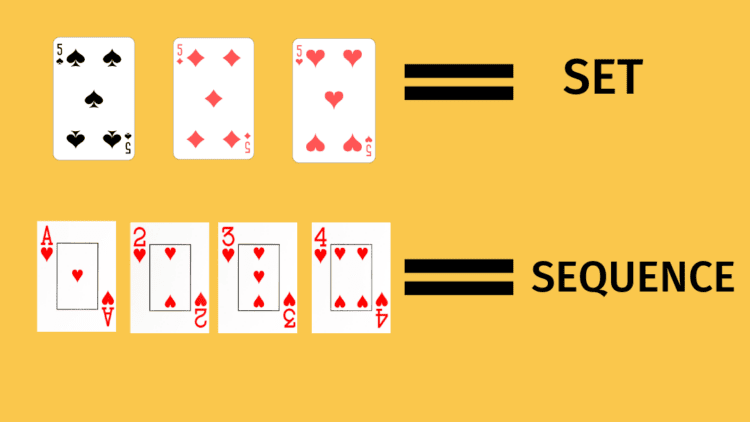
OBJECTIVE OF CONTRACT RUMMY: Get rid of your cards by melding, laying off, or discarding by satisfying each rounds contract.
NUMBER OF PLAYERS: 3-5 players; 4 is optimal
MATERIALS OF CONTRACT RUMMY 52-card deck + 1 joker
TYPE OF GAME: Card game
AUDIENCE: All ages
OVERVIEW OF CONTRACT RUMMY
If you’re a fan of rummy games, you may have encountered a Contract Rummy game before. Contract Rummy is a family of variants with similar features.
Firstly, the game has a particular number of deals. Second, each deal is defined by a contract. The contract is the pattern of melds that must be achieved in order to lay down your cards. Let’s learn about the way you play this style of rummy game. Some of the rules will vary, but the basic principles are the same.
SETUP FOR CONTRACT RUMMY
Most contract rummy games will have a pretty similar setup, although they may have slight variations. If you’re playing contract rummy with more than five players, you can add a second deck with the jokers included. Jokers act as wild cards and can substitute any card.
To start, you need a dealer first. To choose the first dealer, shuffle and cut the deck. Each player will then draw a card, the person who draws the lowest value card deals first. The deal moves to their left.
DEALING
There are seven deals total in Contract Rummy. In the first four deals, players receive 10 cards each. In the remaining deals, players receive 12 cards each. The dealer starts to their left and moves clockwise. Deal the cards one at a time, face-down. Once you have dealt all the cards, the remainder of the deck forms the stock pile. The top card of the stock is flipped over and placed beside it to form the discard pile.
THE CONTRACTS

Like most other rummy games, you must form melds of either runs or sequences. These will be part of your contract. A sequence is four or more consecutive cards of the same suit, such as A, 2, 3, 4, of hearts. A set is three cards of the same rank, no matter the suit, such as 5 of hearts, diamonds, and spades.
The contracts for contract rummy are as follows:
- Deal 1: 10 cards, 2 sets
- Deal 2: 10 cards, 1 set, and 1 sequence
- Deal 3: 10 cards, 2 sequence
- Deal 4: 10 cards, 3 sets
- Deal 5: 12 cards, 2 sets, and 1 sequence
- Deal 6: 12 cards, 1 set, and 2 sequences
- Deal 7: 12 cards, 3 sequences
CONTRACT RULES
- Fulfill the contracts by setting down the appropriate melds for that deal.
- If the contract requires multiple sequences, they can not be from the same suit.
- The seventh round/deal typically requires all cards to be melded at once; this means a meld can be greater than 4 cards.
HOW TO PLAY CONTRACT RUMMY

The play begins with the first player to the dealer’s left and moves clockwise. A turn has three parts: drawing, melding, and discarding.
DRAWING
You have two options when drawing. You can draw the top card from the stockpile, keeping it secret from other players and adding it to your hand. If you choose to take the top card from the stockpile, any other player has the option to take the top card from the discard pile; however, they must take a penalty card from the stockpile as well.
The second option is to draw one or more cards from the discard pile. There is no penalty for taking the top discard card on your turn.
MELDING
Melding is the most important part of contract rummy. You form meld by making combinations of cards in your hand and placing them face-up on the table. You must play the exact number of melds needed for the contract. For example, in round one, you must wait until you can play both sets. Once you do, you have fulfilled your contract. Now, you must wait one full turn before you can play any other cards. This can vary from game to game, but this is the basic idea.
LAYING OFF
After you have fulfilled your contract and waited one turn, you can also ‘lay off’ your cards on pre-existing melds, whether it is their own or other players. Melded cards are scored for the player who melded them, so if you wish to add your card to someone else’s meld, place the card in front of yourself and say which meld you want it to be a part of.
OTHER MELD RULES
- When you need two sequences, they must be different suits. If they are the same suit, they must not be consecutive. For example, 2,3,4,5,6,7,8,9 of hearts counts as one sequence. However, it counts as two sequences if you didn’t have the 6 of hearts.
- In games with more than one deck, the meld can not have 2 cards in a group from the same suit. For example, you can not have 2 five of diamonds and one five of hearts. They must be all different.
- You need to decide beforehand if Aces are high or low.
DISCARDING
After melding, you can now discard. Unless every card in your hand was used to meld you must discard one card face-up on top of the discard pile. If you drew a single card from the top of the discard pile, you are not permitted to discard that card.
JOKERS

Jokers, as mentioned above, are wild cards that may be used to substitute any card needed to complete a meld. You must state the suit and rank of the card they wish to replace it with.
If you have met your contract on a previous turn, and another player used a joker in a sequence to substitute a card you have in your hand, you can exchange those cards and take the joker. The joker, however, must be used during that turn and cannot be saved for later.
Jokers played in sets are dead and cannot be reclaimed.
SCORING
A player ‘goes out’ if they have fulfilled the contract of that round and played all their cards. If this happens, the hand is over for all players, and you can take score. Players collect penalty points for cards in hand.
Face Cards (K, Q, J): 10 points each
Aces: 15 points each
Joker: 15 points
Number Cards: Face Value
END OF GAME
The game ends after all 7 deals. The player with the lowest number of points wins.
CONTRACT RUMMY STRATEGY

Contract rummy games are extremely fun and require very much patience. You can help your chances of winning by following some of the tips below.
CARD MANAGEMENT
One thing you should be aware of is managing your cards well. You should try to meld high-value cards such as face cards and aces first so you don’t end up with them in your hand at the end. You can also keep track of what cards your opponents pick up from the discard pile to roughly calculate what melds they are going for.
MELDING STRATEGIES
Another good tip is to focus on melding cards early. You want to minimize the risk of getting stuck with high-value cards if someone goes out. Try to create multiple melds in a single turn to increase your chances of going out early and ending the round
PRIORITIZE ROUNDS
You should also pay close attention to the game’s rounds. Each round may require a slightly different strategy. You should try to prioritize the contracts that require fewer melds to complete. You can try to save high-value cards for rounds with contracts that go with your existing melds to lower your chances of accumulating points.
If you like the sound of contract rummy, check out Shanghai Rummy and Continental Rummy.
- 20+ Epic Outdoor Drinking Games - June 28, 2024
- 30 Gifts for Board Game Lovers - June 27, 2024
- 33 Games for Church Youth Group - June 21, 2024